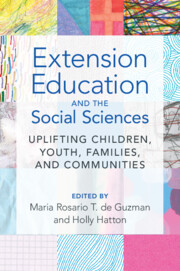Book contents
- Extension Education and the Social Sciences
- Extension Education and the Social Sciences
- Copyright page
- Contents
- Contributors
- Part I Overview of Extension and the Social Sciences
- Part II Addressing Key Issues in the Well-Being of Children, Youth, and Families
- Part III Looking Ahead: Emerging Issues and Trends
- Chapter 10 Cooperative Extension and Diversity
- Chapter 11 Reaching and Serving Underrepresented Families
- Chapter 12 Preparing the Next Generation of Extension Professionals
- Chapter 13 Extending Extension’s Outreach and Engagement with Social Media
- Index
- References
Chapter 11 - Reaching and Serving Underrepresented Families
The Necessity of Engaging Fathers in Extension Programming
from Part III - Looking Ahead: Emerging Issues and Trends
Published online by Cambridge University Press: 28 March 2024
- Extension Education and the Social Sciences
- Extension Education and the Social Sciences
- Copyright page
- Contents
- Contributors
- Part I Overview of Extension and the Social Sciences
- Part II Addressing Key Issues in the Well-Being of Children, Youth, and Families
- Part III Looking Ahead: Emerging Issues and Trends
- Chapter 10 Cooperative Extension and Diversity
- Chapter 11 Reaching and Serving Underrepresented Families
- Chapter 12 Preparing the Next Generation of Extension Professionals
- Chapter 13 Extending Extension’s Outreach and Engagement with Social Media
- Index
- References
Summary
Extension is uniquely positioned to reach and support underserved and underrepresented families. Although Extension excels at providing evidence-based programming for mothers, children, and youth, it has generally been less successful in engaging fathers. Recent evidence finds increased balanced sharing of caregiving responsibilities and fathers’ desire to engage with their children. Engaging fathers and incorporating father-centric programming is more important than ever. This chapter will highlight promising strategies for engaging fathers in Extension, including an example of a statewide needs assessment, technology-based programming, and community-based partnerships. We describe available evidence-based programs and approaches, both currently utilized with fathers and aptly positioned to accommodate fathers, along with promising opportunities and important considerations for Extension moving forward. Shifting the focus to better serve fathers in family-based programming will better engage and support underserved and vulnerable families, and Extension is a system that is critically important for meeting this challenge.
- Type
- Chapter
- Information
- Extension Education and the Social SciencesUplifting Children, Youth, Families, and Communities, pp. 224 - 245Publisher: Cambridge University PressPrint publication year: 2024



